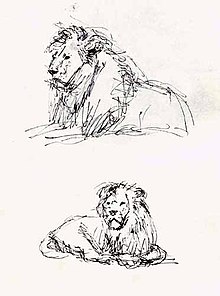Sketch (drawing)
The WikiProject banner below should be moved to this article's talk page. If this is a demonstration of the template, please set the parameter |category=no to prevent this page being miscategorised. |
| Visual arts Unassessed | |||||||
| |||||||

pen and china ink on paper
by Frans Koppelaar
A sketch is a rapidly executed freehand drawing that is not intended as a finished work, often consisting of a multitude of overlapping lines. Sketches usually serve quickly to record ideas for later use. Sketches are inexpensive and allow the artist to try out different ideas before committing to an expensive and time consuming painting or fresco. Sketching sharpens an artist's ability to focus and has often been a prescribed part of artistic development for student and professional alike.
Dry media such as pencil or pastel are often preferred due to time constraints, but a quickly done watercolor study or even quickly modeled clay or soft wax can also be considered a 'sketch' in the broader sense of the term. Graphite pencils being a relatively new invention, the artists of the Renaissance made sketches using a silver stylus on specially prepared paper (known as silverpoint), with results similar to a modern pencil sketch, or used charcoal, chalk, or pen-and-ink.
Contrary to popular belief, artists often use erasers when drawing; the eraser may be used to remove rough construction lines, or to soften lines for visual effect. The most commonly used eraser for pencil drawing is the kneaded eraser, which has a soft, sticky surface that enables the artist to lift the graphite or charcoal from the drawing surface without smudging. White plastic erasers can cleanly erase line work, but tend to smudge heavy shading.
The sketchbooks of Leonardo da Vinci and Edgar Degas are two examples of many done by famous artists which have become art objects in their own right, although many pages show more thoughtful studies rather than true sketches.
The ability to quickly record impressions through sketching has found varied purposes in today's culture. Courtroom artists are usually sketchers. Sketches drawn to help authorities find or identify wanted people are called forensic sketches. Street performers in popular tourist areas often include artists who sketch portraits within minutes.
A sketch method of reproducing photographs is done with a photographic enlarger in a dark room. The image is projected on to the paper where the sketch is to be done. All the light shades are penciled until the paper is all the same shade.
See also
External links
- Multiuser real-time drawing and chatting on the web.
- Is Sketching Gesturing?
- Digital Doodle, Draw doodles online.

